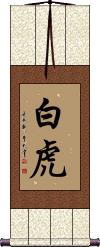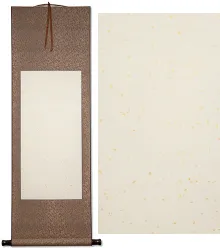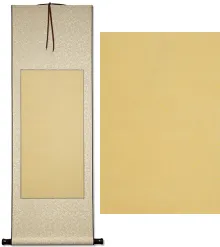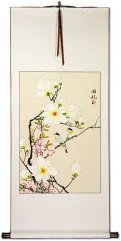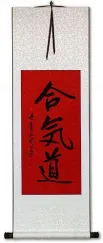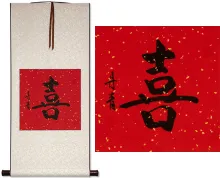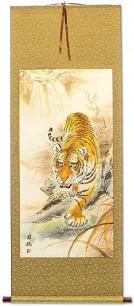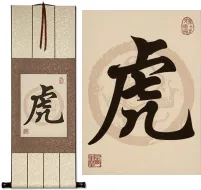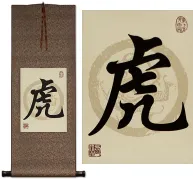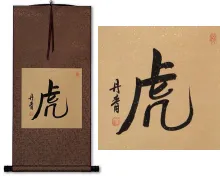Many custom options...
And formats...

White Tiger in Chinese / Japanese...
Buy a White Tiger calligraphy wall scroll here!
White Tiger
白虎 is the title “White Tiger” in Chinese, Japanese, and old Korean Hanja.
In Chinese folklore, the White Tiger rules or represents the seven mansions (constellations) of the western sky. However, in modern Chinese, a “white tiger” is also slang for hairless female genitalia (be careful about this, as Chinese men might secretly laugh or snicker when they see your white tiger wall scroll).
In Japanese folklore, the White Tiger is a god said to rule over the western heavens. They also know of the Chinese seven mansions of the western heavens. In Japanese, this can also be the given name Byakko.
This in-stock artwork might be what you are looking for, and ships right away...
Gallery Price: $268.00
Your Price: $148.88
Gallery Price: $60.00
Your Price: $36.88
Gallery Price: $60.00
Your Price: $36.88
Gallery Price: $60.00
Your Price: $36.88
Gallery Price: $87.00
Your Price: $47.88
Gallery Price: $65.00
Your Price: $39.88
Gallery Price: $90.00
Your Price: $49.88
Gallery Price: $40.00
Your Price: $16.88
Gallery Price: $65.00
Your Price: $39.88
Not the results for white tiger that you were looking for?
Below are some entries from our dictionary that may match your white tiger search...
| Characters If shown, 2nd row is Simp. Chinese |
Pronunciation Romanization |
Simple Dictionary Definition |
白虎 see styles |
bái hǔ bai2 hu3 pai hu byakko びゃっこ |
More info & calligraphy: White Tiger(1) (See 四神) White Tiger (Taoist god said to rule over the western heavens); (2) {astron} (See 二十八宿) seven mansions (Chinese constellations) of the western heavens; (given name) Byakko |
甝 see styles |
hán han2 han |
white tiger |
鵺 see styles |
yè ye4 yeh nue ぬえ |
a kind of bird similar to pheasant (1) Japanese chimera; mythical creature with a monkey's head, tanuki's body, tiger's limbs, and a snake tail; (2) White's thrush (Zoothera dauma); (3) man of mystery; enigma; (female given name) Nue |
四象 see styles |
sì xiàng si4 xiang4 ssu hsiang shishou / shisho ししょう |
four divisions (of the twenty-eight constellations 二十八宿[er4 shi2 ba1 xiu4] of the sky into groups of seven mansions), namely: Azure Dragon 青龍|青龙[Qing1 long2], White Tiger 白虎[Bai2 hu3], Vermilion Bird 朱雀[Zhu1 que4], Black Tortoise 玄武[Xuan2 wu3] four images; four symbols; four emblems; four phenomena; four phases; (given name) Shishou |
白虎觀 白虎观 see styles |
bái hǔ guàn bai2 hu3 guan4 pai hu kuan |
White Tiger Hall, a Han dynasty palace hall in which the famous Virtuous Discussions Held in White Tiger Hall 白虎通德論|白虎通德论 were held under the aegis of Han Emperor Zhang 漢章帝|汉章帝 |
Variations: |
nue ぬえ |
(1) Japanese chimera; mythical creature with a monkey's head, tanuki's body, tiger's limbs, and a snake tail; (2) (See トラツグミ) White's thrush (Zoothera dauma); (3) mysterious person; person of unknown character; enigma |
Variations: |
howaitotaigaa; howaito taigaa / howaitotaiga; howaito taiga ホワイトタイガー; ホワイト・タイガー |
white tiger (var. of Bengal tiger); bleached tiger |
Variations: |
鐃循wai鐃夙wa申鐃緒申鐃緒申鐃緒申; 鐃循wai鐃夙¥申鐃緒申鐃緒申鐃緒申鐃緒申 鐃循ワイ鐃夙ワ申鐃緒申鐃緒申鐃緒申; 鐃循ワイ鐃夙¥申鐃緒申鐃緒申鐃緒申鐃緒申 |
white tiger (var. of Bengal tiger); bleached tiger |
The following table may be helpful for those studying Chinese or Japanese...
| Title | Characters | Romaji (Romanized Japanese) | Various forms of Romanized Chinese | |
| White Tiger | 白虎 | byakko / hakko byako / hako | bái hǔ / bai2 hu3 / bai hu / baihu | pai hu / paihu |
Successful Chinese Character and Japanese Kanji calligraphy searches within the last few hours...
